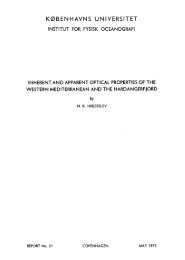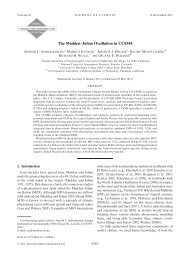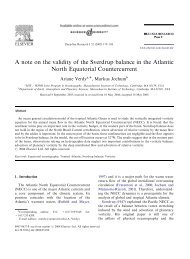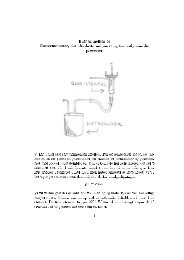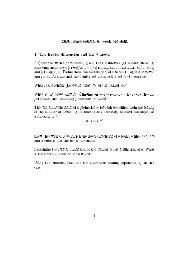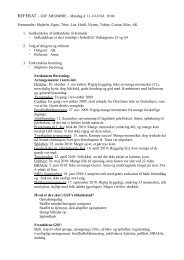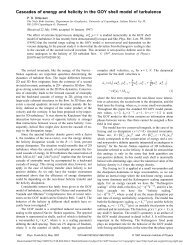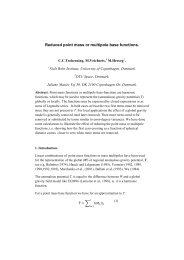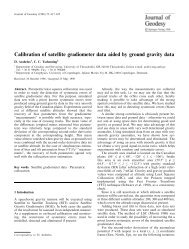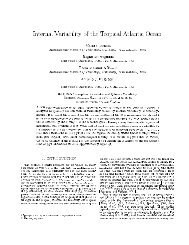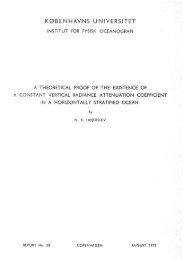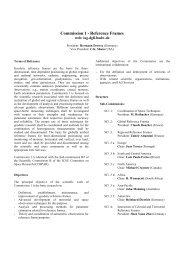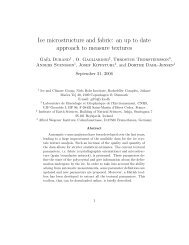Retrieving a common accumulation record - Niels Bohr Institutet
Retrieving a common accumulation record - Niels Bohr Institutet
Retrieving a common accumulation record - Niels Bohr Institutet
Create successful ePaper yourself
Turn your PDF publications into a flip-book with our unique Google optimized e-Paper software.
JOURNAL OF GEOPHYSICAL RESEARCH, VOL. , XXXX, DOI:10.1029/,<strong>Retrieving</strong> a <strong>common</strong> <strong>accumulation</strong> <strong>record</strong> from Greenlandice cores for the past 1800 yearsK. K. Andersen, P. D. Ditlevsen, S. O. Rasmussen, H. B. Clausen, B. M. Vintherand S. J. JohnsenIce and Climate, <strong>Niels</strong> <strong>Bohr</strong> Institute, University of Copenhagen, Copenhagen,Denmark———————————————————————— ————————————————————————K. K. Andersen, Ice and Climate, <strong>Niels</strong> <strong>Bohr</strong> Institute, University of Copenhagen, Denmark.(kka@gfy.ku.dk)D R A F T October 13, 2005, 3:29pm D R A F T
X - 2Abstract.ANDERSEN ET AL.: 1800 YEARS ACCUMULATION RECORDIn the <strong>accumulation</strong> zone of the Greenland ice sheet the annual<strong>accumulation</strong> rate may be determined through identification of the annual cyclein the isotopic climate signal and other parameters that exhibit seasonal variations.On an annual basis the <strong>accumulation</strong> rate in different Greenland ice coresis highly variable, and the degree of correlation between <strong>accumulation</strong> series fromdifferent ice cores is low. However, when using multi year averages of the different<strong>accumulation</strong> <strong>record</strong>s the correlation increases significantly. A statisticalmodel has been developed to estimate the <strong>common</strong> climate signal in the different<strong>accumulation</strong> <strong>record</strong>s through optimization of the ratio between the varianceof the <strong>common</strong> signal and of the residual. Using this model a <strong>common</strong> Greenland<strong>accumulation</strong> <strong>record</strong> with five years resolution for the past 1800 years hasbeen extracted. The <strong>record</strong> establishes a climatic <strong>record</strong> which implies that verydry conditions during the 13th century together with dry and cold spells duringthe 14th century may have put extra strain on the Norse population in Greenlandand have contributed to their extinction.D R A F T October 13, 2005, 3:29pm D R A F T
ANDERSEN ET AL.: 1800 YEARS ACCUMULATION RECORD X - 31. IntroductionThe net precipitation rate in the <strong>accumulation</strong> zone of an ice sheet is <strong>record</strong>ed in the annual icelayer thickness profile which may be obtained from ice cores. However, due to local fluctuationsand especially variations in the snow surface due to drift (sastrugies) the signal to noise varianceratio is rather poor, of the order 1–3, as established from comparisons of different shallow coresdrilled close to one another [Fisher et al., 1985]. The deep ice cores in Greenland are distributedmainly along the ice divide. As demonstrated by several authors these cores contain a <strong>common</strong>climatic signal over the large scale climatic changes during the last glacial period [e.g., Johnsenet al., 2001]. In order to separate the <strong>common</strong> climatic information from local phenomena andnoise for the shorter term variations during climatically stable periods it is however crucial toimprove the signal to noise ratio. Crüger et al., [2004] showed that it is problematic to assumea <strong>common</strong> signal in <strong>record</strong>s from different sites on the Greenland ice sheet on short time scales,but we expect extreme features and long-term variations to be concurrent over large parts ofGreenland.2. The ice cores and ice flowIn this work we compare the annual ice layer thickness profiles from five Greenland ice cores.The cores were chosen to ensure relatively long <strong>accumulation</strong> <strong>record</strong>s of annual resolution overa <strong>common</strong> time period. The cores used in this study are the DYE-3 [Dansgaard et al., 1982],the Milcent [Hammer et al., 1978], the Crete [Hammer et al., 1980], the GRIP [Johnsen et al.,1992] and the NorthGRIP (NGRIP) [Johnsen et al., 2001; NorthGRIP members, 2004] ice cores.Details about the location, length and <strong>accumulation</strong> rates of these cores are given in Table 1.D R A F T October 13, 2005, 3:29pm D R A F T
X - 4ANDERSEN ET AL.: 1800 YEARS ACCUMULATION RECORDThe NGRIP, GRIP and Crete ice cores are all located very close to the ice divide, GRIP andCrete in the center of the Greenland ice sheet and NGRIP 324 kilometers NNW of the GRIPdrill site. Milcent is in the central part of Greenland, but about 260 km west of the ice divide,whereas the DYE-3 drill site is located on the southern part of the ice sheet, about 30 km eastof the ice divide. The ice cores used for this study are thus rather widely spaced, and all sitesare subject to local meteorological conditions. Moreover the cores derive from both sides ofthe ice divide, which is known to influence the <strong>record</strong>ed signal [Clausen et al., 1988; Rogers etal., 2002] as the sites are affected by different air masses. Nevertheless it is expected that to afirst approximation these ice cores share a <strong>common</strong> climate signal on an annual to decadal scale,which we here wish to extract. The <strong>accumulation</strong> rates were determined by identifying andcounting annual layers as determined from the high resolution δ 18 O and Electrical ConductivityMeasurement (ECM) <strong>record</strong>s. In the case of North GRIP these <strong>record</strong>s were supported by IonChromatographic measurements at 5 cm resolution over the upper 350 m (Andersen et al., inpreparation). The stratigraphy of the single cores has been cross-checked using known volcanichorizons and ECM as also described by Vinther et al. (in preparation). The dating uncertaintyis estimated to be 1-2 years over the first millenium increasing to a few years at the end of the<strong>record</strong>s used here.In order to derive annual <strong>accumulation</strong> rates from the observed annual layer thicknesses, thedata had to be corrected for densification and thinning of the ice layers due to ice flow. Thiswas done by using a flow model [Johnsen et al., 1992; Johnsen et al., 1999] also accountingfor the firnification at the top of the ice. In this way we obtained cross-dated chronologicaltime series of annual <strong>accumulation</strong> rates over the latest two millenia, with relative dating errorsbeing at most a few years. The ice flow in the DYE-3 region is complicated by upstream surfaceD R A F T October 13, 2005, 3:29pm D R A F T
ANDERSEN ET AL.: 1800 YEARS ACCUMULATION RECORD X - 5undulations, and the obtained <strong>accumulation</strong> rate profile thus contains longer term variations ofnon-climatic origin [Reeh, 1989]. In order to remove these variations we have filtered the DYE-3<strong>accumulation</strong> <strong>record</strong> with a Butterworth filter of order 3 with a cut-off frequency of 0.003 year −1 ,eliminating the lowest frequency variations. The obtained <strong>accumulation</strong> <strong>record</strong>s are shown asfive year average values in Figure 1.The most <strong>common</strong>ly used climatic parameter obtained from Greenland ice cores is the δ 18 O<strong>record</strong>, which is a proxy for the temperature at the location of formation of the precipitation.However as indicated by model simulations [e.g. Werner et al., 2000] the δ 18 O signal is modulatedby the amount of precipitation formed at a given time and temperature. The amount ofprecipitation is thus in some aspects a more direct climate signal than δ 18 O. Across large-scaleclimatic changes, like the Dansgaard Oeschger events, there is a clear correlation between δ 18 Oand <strong>accumulation</strong> rates [Dahl-Jensen, 1993]. Kapsner et al [1995] and Crüger et al [2004] havehowever shown that both during the most recent Holocene and the transition out of the last glacialperiod atmospheric circulation had larger influence on <strong>accumulation</strong> than temperature. Figure 2shows scatter plots of δ 18 O versus the logarithm of the <strong>accumulation</strong> for the <strong>record</strong>s used in thisstudy. Although the correlation is rather weak it is thus expected that different information maybe obtained from the two <strong>record</strong>s, especially during relatively stable climate periods.3. Statistical Distribution of Annual Layer ThicknessesThe time series of annual <strong>accumulation</strong> rates obtained after correction for flow and compressionare shown in Figure 1. It may be seen that the variance of each <strong>record</strong> roughly scales with the meanvalue (note the different axis scaling). The statistical distribution of annual layer thicknessesfrom each of the drill sites is shown in Figure 3. The <strong>accumulation</strong> rates from especially Creteand Milcent take on discrete values, as these ice cores like the DYE-3 core were sampled withD R A F T October 13, 2005, 3:29pm D R A F T
X - 6ANDERSEN ET AL.: 1800 YEARS ACCUMULATION RECORDa constant number of samples per year according to a predicted model time scale. The GRIPand NGRIP cores were cut in samples of constant size, and the discrete spectrum of values ischanged into a continuous spectrum when correcting the annual layer thicknesses for the effectof layer thinning. The distributions are observed not to be symmetric around the mean. Whenplotted on a logarithmic <strong>accumulation</strong> axis the distributions become approximately symmetric,with a shape close to a normal distribution, as also observed by Rasmussen et al. [2005] forthe <strong>accumulation</strong> <strong>record</strong> from the Early Holocene, Younger Dryas and Bølling sections of theNGRIP core. It may be expected that the <strong>accumulation</strong> rates follow Gamma distributions, as theyare derived as the sum of positive independent precipitation events. Due to the discrete samplingrates and the limited number of annual layers in the <strong>record</strong>s we can however not distinguishbetween this and a lognormal distribution. In the following we will for simplicity use the factthat the logarithm of the <strong>accumulation</strong> rates is approximately normally distributed.4. The Noise ModelFrom the set of available <strong>accumulation</strong> series we want to estimate a <strong>common</strong> <strong>accumulation</strong><strong>record</strong> signifying the variability in the mean regional precipitation over the past millenia. Thissignal is denoted x(t). As pointed out by e.g. Fisher et al. [1985] the variance in the <strong>accumulation</strong>is ascribable to temporal, regional areal and local areal variability. We are here only interested inthe <strong>common</strong> temporal variability. The local variability due to blowing snow and heterogenoussnowfall is considerably diminished through temporal averaging over intervals of a few years.The regional areal variability may be ascribed to varying atmospheric circulation and storm tracktogether with orography [Ohmura and Reeh, 1991; Dethloff et al., 2002; Crüger et al., 2004]As a first approximation we can assume that the measured <strong>accumulation</strong> at site i, denoted x i (t),receives a contribution from the <strong>common</strong> signal x(t) with some site specific scaling constant α i .D R A F T October 13, 2005, 3:29pm D R A F T
ANDERSEN ET AL.: 1800 YEARS ACCUMULATION RECORD X - 7In addition, x i (t) may contain regional variability, but it is here treated as noise such that themeasured signal is given as,x i (t) = α i x(t) + σ i η i (t). (1)The residual η i (t) is assumed have zero mean and unit variance such that σi 2 is the varianceof the residual term. Further we will assume that the residual terms at two different sites i andj are uncorrelated; 〈η i η j 〉 = δ ij , where 〈·〉 represents the temporal mean. As shown above themeasured <strong>accumulation</strong> rates x i are lognormally distributed. The noise as defined here consistsof two main contributions, the larger scale variability from site to site, which as a first estimate canbe regarded as white noise, and the glaciological noise which is blue noise for annually resolved<strong>record</strong>s [Fisher et al., 1985]. The blue noise may be ascribed to blowing snow (sastrugies) anddiscrete measurements sampling but it can efficiently be reduced by temporal averaging, and theassumption that η i (t) can be regarded as white noise is thus reasonable if we use <strong>accumulation</strong> dataaveraged over intervals large enough to remove the blue noise characteristics of the glaciologicalnoise.Even though we do not know to which extent x(t) is a stationary stochastic process we willtreat it as such and define the (unknown) signal variance,σ 2 = 〈x 2 〉 − 〈x〉 2 . (2)4.1. Temporal AveragingAfter having corrected for layer thinning and snow compression the annual layer thickness isa measure of the accumulated precipitation including noise attributable to drifting snow.If the climate signal is auto correlated over times longer than the sampling time the noise canbe reduced by temporal averaging of the signal. By doing that we of course loose information onD R A F T October 13, 2005, 3:29pm D R A F T
X - 8ANDERSEN ET AL.: 1800 YEARS ACCUMULATION RECORDthe fluctuations of the climate signal on timescales faster than the averaging time. With only fewnoisy timeseries available some temporal averaging is however necessary in order to improvethe signal to noise variance ratio. Consider two <strong>record</strong>s x i (t) and x j (t) related according to (1).With y i ≡ x i − 〈x i 〉 and y j ≡ x j − 〈x j 〉 being the deviations from the average, the temporalaverage over any odd number m of points is,y i (t) = 1 µ∑y i (t + k), µ = (m − 1)/2. (3)mk=−µThe covariance between the series is then given by:〈y i y j 〉 = 1 ∑ µ µ∑〈ym 2 i (t + k)y j (t + l)〉. (4)k=−µ l=−µWith the deviation from the climate signal being defined as y = x − 〈x〉 we have,〈y i (t + k)y j (t + l)〉 = α i α j 〈y(t + k)y(t + l)〉 + σ 2 i δ ij δ kl= α i α j c(k − l) + σ 2 i δ ij δ kl , (5)where we have introduced the autocovariance c(τ) = 〈y(t)y(t + τ)〉 for the climate signal. δ ijis the Kronecker delta. By inserting this into (4) we obtain,〈y i y j 〉 = 1 ]m−1m α ∑ m − kiα j[c(0) + 2k=1m c(k) + σ2 iδ ijα i α j= 1 []m α iα j I[c] +σ2 iδ ij , (6)α i α jwhere I[c] ≡ c(0)+2 ∑ m−1k=1 c(k)(m−k)/m. Finally we have the expression for the correlationcoefficient,C ij = 〈y i y j 〉/ √ 〈y 2 i 〉〈y 2 j〉[ ( σ2= 1 + i+ σ2 jαi2 αj2) 1I[c] + ( σ2i σ 2 jα 2 i α 2 j) 1I[c] 2 ] −1/2. (7)D R A F T October 13, 2005, 3:29pm D R A F T
ANDERSEN ET AL.: 1800 YEARS ACCUMULATION RECORD X - 9If the climate signal is assumed to be a red noise signal with autocorrelation c(t) =σ 2 exp(−|t|/T ), where T is the correlation time, then by approximating the sum with an integralwe obtain,I[c] = 2σ 2 T[1 + T m (exp (−m/T ) − 1) ]. (8)Figure 4 shows the correlation coefficients between all pairs of <strong>record</strong>s used for this study,when averaging over an increasing numbers of years. Based on the findings in Section 3 theaverages have been taken over the logarithm of the data. The maximum correlation of 0.72 isobtained between the GRIP and the Crete ice cores when averaging over more than 20 years.A correlation time of about 10 years may be anticipated, and a comparison with the resultobtained from (7) using T =10 years agrees well with the ice core data for longer term averages(dashed curve in Figure 4). For short term averages the correlation coefficients between allpairs of <strong>record</strong>s increase faster than the theoretical result of (7) in agreement with the blue noisespectrum observed by Fisher et al. [1985], while the curves follow the shape of the theoreticalresult for averaging lengths above 3-5 years. We thus conclude that the major part of the bluenoise has been removed when averaging over 5 year intervals, and apply this averaging approachin the rest of this work, assuming that the residual term η i (t) can be regarded as white noise.5. Determination of model parametersWith <strong>accumulation</strong> series from n ice cores we have to determine 2n + 1 unknown parameters,namely (α i , σ i ) for i = 1, ..., n and σ. The overall magnitude of the climate signal is arbitrary,and we set 〈x〉 = 1. The variance of the climate signal (2) then becomes σ 2 = 〈x 2 〉 − 1.Equations for the signal scaling parameters α i may be estimated from averaging (1) over theD R A F T October 13, 2005, 3:29pm D R A F T
X - 10ANDERSEN ET AL.: 1800 YEARS ACCUMULATION RECORDwhole length of the series,〈x i 〉 = α i 〈x〉 = α i . (9)Further equations can be derived from the covariance matrix. Assuming that the signals x i (t)are stationary processes the covariance c ij between two signals may be calculated asc ij = 〈x i x j 〉 = 〈(α i x + σ i η i )(α j x + σ j η j )〉= α i α j 〈x 2 〉 + σ 2 i δ ij= α i α j (σ 2 + 1) + σ 2 i δ ij . (10)The set of equations from (9) and (10) is overdetermined and is solved by finding the set ofestimated parameters ˜α i , ˜σ i , and ˜σ that minimizes the total misfit M defined asM =+n∑( ˜α i − 〈x i 〉) 2i=1n∑ n∑ (˜α i ˜α j (˜σ 2 + 1) + ˜σ i 2 δ ij − 〈x i x j 〉 ) 2. (11)i=1 j=iFor the minimalization, the initial guesses were ˜α i = 〈x i 〉, ˜σ i = 0.8 · std(x i ) and ˜σ 2 = 0.002,but the estimated parameter values are insensitive to the choice of initial guesses, as long asreasonable values are used.6. The Optimal Climate SignalWe now want to use the results of the presented model to calculate an estimate ˜x(t) of the<strong>common</strong> climate signal x(t) extracting maximum information on the <strong>common</strong> climate variabilityin the <strong>record</strong>s. The method applied finds the linear combination of the individual <strong>record</strong>s whichoptimizes the ratio between the variance of the <strong>common</strong> signal and the variance of the residual,as estimated from the model.6.1. The <strong>accumulation</strong> reconstructionD R A F T October 13, 2005, 3:29pm D R A F T
ANDERSEN ET AL.: 1800 YEARS ACCUMULATION RECORD X - 11Based on the model given in (1), equations (9) and (10) may be combined to give the expressionfor the variance of any of the measured series x i〈x 2 i 〉 − 〈x i 〉 2 = α 2 i σ 2 + σ 2 i . (12)With the presented model the ratio, F i , between the total variance of a <strong>record</strong> and the varianceof the residual is given asF i = variance of <strong>record</strong> / variance of residual = (α i σ/σ i ) 2 + 1. (13)The estimate ˜x(t) of the <strong>common</strong> climate signal will be constructed such that the modelbased ratio between the variance of the total signal and the residual is maximized. The linearcombination is expressed as˜x(t) = ∑ iγ i x i , (14)with the coefficients γ i being determined such that ˜x(t) represents x(t) as closely as possible.We can do this in two different ways which lead to the same result. Firstly the linearcombination which maximizes F˜x may be found directly. Combining (1) and (14) one gets˜x(t) = ∑ i(γ i α i x(t) + γ i σ i η i (t)). The signal to residual variance ratio F˜x for any linear combinationof x i ’s may be expressed asF˜x = (∑ i γ i α i ) 2 σ 2+ 1, (15)∑i(γ i σ i ) 2from which we have,∂F˜x∂γ k∑ ⎡⎤= 2σ2 i γ i α i ∑( ∑ ⎣αi(γ i σ i ) 2 ) 2 k (γ j σ j ) 2 − γ k σk2 ∑γ j α j⎦ . (16)jjBy redefining ˜γ j = γ j σ 2 j /α j we get,∂F˜x∂γ k= 0 ⇒ ∑ j(˜γ j − ˜γ k )( α jσ j) 2˜γ j = 0, (17)D R A F T October 13, 2005, 3:29pm D R A F T
X - 12ANDERSEN ET AL.: 1800 YEARS ACCUMULATION RECORDwith the solution ˜γ j = ˜γ for all j, where ˜γ is an arbitrary constant. From the definition above wethus get γ j = α j /σj 2 . As an alternative to maximizing the signal to residual variance ratio we cansimply determine ˜x(t) by minimizing the root mean square error between a linear combinationof the series x i (t) and (the unknown) x(t). This results in the same linear combination as above.The estimated optimal climate <strong>record</strong> can thus be represented as,˜x(t) = ∑ i= ∑ i( )αiσi2 ( (αix i (t)σ i) 2x(t) +( αiσ i)η i (t)). (18)The estimated model parameters determined for the five ice core <strong>record</strong>s over the <strong>common</strong> timeinterval, A. D. 1177-1972 are given in Table 2. The values for α i found by the minimalizationprocedure agree well with the <strong>accumulation</strong> rates given in Table 1, although those are averagesover recent years, whereas the α i ’s correspond to long term averages. As expected high σ i ’sare found for the high <strong>accumulation</strong> sites. The model assumption that the residual signals aremutually uncorrelated was checked with the estimated series, and is largely confirmed. We findcomparable modeled signal to residual variance ratios for all <strong>record</strong>s cores investigated here,meaning that all cores have comparable influence on the <strong>common</strong> signal. DYE-3 has the lowestratio, which probably reflects the fact the DYE-3 is located east of the ice divide and considerablyfurther south than the other ice cores included in this study. The DYE-3 site receives a largerproportion of its precipitation from cyclonic activity associated with the Icelandic low than theother cores. Moreover as mentioned earlier the DYE-3 <strong>accumulation</strong> <strong>record</strong> had to be correctedfor ice flow at the site. When comparing the signal to residual ratios in this study with thesignal to noise ratio estimates by Fisher et al. [1985] their values, especially for DYE-3, areconsiderably higher than what is found here (note that the definition of their ratios correspondto equation (13)minus 1). Fisher et al. [1985] in their study investigated the local signal toD R A F T October 13, 2005, 3:29pm D R A F T
ANDERSEN ET AL.: 1800 YEARS ACCUMULATION RECORD X - 13noise variance ratio by comparing the noise in a number of ice cores drilled close to another,whereas we here aim at the <strong>common</strong> signal over Greenland, considering everything else as theresidual. The definition of noise in the two studies is thus inherently different and can not readilybe compared.6.2. Sensitivity of the reconstructionThe stratigraphically dated <strong>record</strong>s used in this study are of different lengths.The Creteand Milcent ice cores are intermediate length ice cores of about 400 m, and the length of the<strong>record</strong>s presented is determined by the length of the cores. The DYE-3, GRIP and NGRIP icecores are all deep ice cores reaching back through the last glacial period. The length of theannual <strong>accumulation</strong> <strong>record</strong>s presented here is determined by the length of the stratigraphicallydated uppermost part of the ice cores. The length of each stratigraphy is limited by the initial<strong>accumulation</strong> rate at the site determining the isotopic diffusion, together with the samplingresolution and the location of the brittle zone in the cores. The <strong>accumulation</strong> at the DYE-3drilling site is high enough to preserve annual cycles in the isotopic signal throughout most ofthe Holocene. Hammer et al. [1986] used this fact to count annual layers continuously backto 5.9 ka BP and in sequences to about 8 ka BP. Vinther et al. (in preparation) have refinedthe isotopic measurements and present an improved Greenland stratigraphy for the past 8.2 ka.This together with the work of Rasmussen et al. [2005] comprises the new "Greenland Ice CoreChronology 2005" (GICC05) throughout the Holocene period, combining and cross-dating thebest available measurements from the NGRIP, GRIP and DYE-3 <strong>record</strong>s. In the work presented,the DYE-3 and GRIP stratigraphies have only been used over the period <strong>common</strong> with the NGRIP<strong>accumulation</strong> <strong>record</strong>.D R A F T October 13, 2005, 3:29pm D R A F T
X - 14ANDERSEN ET AL.: 1800 YEARS ACCUMULATION RECORDFrom the five cores we have calculated three estimates of the <strong>common</strong> <strong>accumulation</strong> curve asshown in Figure 5. The three curves are constructed by using the three, four, and five longest<strong>record</strong>s over their <strong>common</strong> period, respectively. The three resulting curves show convincingagreement over their <strong>common</strong> periods, and all major minima and maxima recur in all curves.We will thus in the following treat the longest <strong>record</strong>, based on NGRIP, GRIP and DYE-3 as a<strong>common</strong> <strong>accumulation</strong> rate reconstruction.When estimating the parameters for the optimal climate curve, the original <strong>accumulation</strong>data are first averaged over discrete five year bins. These bins can of course be constructed infive different ways, and Figure 6 illustrates the variability associated with the choice of bins.Although differences are obvious, choosing a different set of bins does not significantly changethe location of prominent maxima and minima.6.3. The <strong>accumulation</strong> and the isotopic climate <strong>record</strong>sThe resulting <strong>accumulation</strong> curve is displayed together with the corresponding stacked δ 18 Osignal in Figure 6. As expected the two curves show only few similarities when comparedwith five year resolution over the past 1800 years.A few <strong>common</strong>alities may however benoted. Accumulation rates as well as δ 18 O values show a decreasing trend over the 8th and9th centuries followed by a steeper increase around A. D. 900 and another decrease over thefollowing centuries. The decreasing trend in <strong>accumulation</strong> rate after A. D. 1800 is one of the fewfeatures in Figure 5 which actually depend on which cores are involved in the reconstruction. Aweak decrease is found in NGRIP, but+ a stronger decrease is mainly seen for DYE-3 (Figure 1),with low values around A. D. 1950 and just before A. D. 1970. We do not consider this aregional Greenland signal, but a local South Greenland signal, probably connected to atmosphericcirculation changes. The slight increase in δ 18 O over the past centuries is again strongest in DYE-D R A F T October 13, 2005, 3:29pm D R A F T
ANDERSEN ET AL.: 1800 YEARS ACCUMULATION RECORD X - 153, but is also found for NGRIP. In NGRIP it is however followed by low values during the 1980’sand early 1990’s which are not included in the <strong>common</strong> period investigated here. On top ofthese longer term variations the latest centuries of the <strong>common</strong> <strong>accumulation</strong> and δ 18 O curvesare characterized by concordant faster variations. Synchronous minima are found around 1836,1873, 1883 and 1910 to 1920. Large volcanic eruptions are known to have climatic influence andin Greenland also to influence the δ 18 O values. Most of these <strong>common</strong> minima in fact may beconnected to volcanic eruptions. The minima in 1836 coincide with the eruption of Coseguina,Nicaragua with a Volcanic Explocivity Index (VEI) of 5 in late 1835. The minima in the early1880s are most probably related to the 1883 Krakatoa eruption. The minima around 1865 canhowever not immediately be connected to any volcanic eruptions.Synchronous sharp decreases in the presented <strong>common</strong> <strong>accumulation</strong> and δ 18 O <strong>record</strong>s maythus often be related to larger volcanic events. On the other hand smaller eruptions with smallereffect on climate may result in decreases in <strong>accumulation</strong> rate and δ 18 O for all of the investigatedcores within one or two years, even though this does not emerge from the combined five year<strong>record</strong>s displayed here. When looking at the earliest part of the <strong>record</strong> very low δ 18 O valuesare found around A. D. 530, probably connected to a strong volcanic horizon in A. D. 529.Despite the very low δ 18 O values a corresponding drop in <strong>accumulation</strong> is not found, although itcoincides with a longer period of relatively low <strong>accumulation</strong> rates. A second strong minimumin δ 18 O is found around A. D. 680, but the apparently corresponding minimum in <strong>accumulation</strong>is in fact not synchronous, it only occurs 20 years later, around A. D. 700.6.4. Climatic implications of the <strong>common</strong> <strong>accumulation</strong> <strong>record</strong>Focusing on the <strong>common</strong> <strong>accumulation</strong> <strong>record</strong> in Figure 6 some very interesting features maybe noted. Several occurrences of very dry spells are found during the periods A. D. 450, 700,D R A F T October 13, 2005, 3:29pm D R A F T
X - 16ANDERSEN ET AL.: 1800 YEARS ACCUMULATION RECORDaround A. D. 1000 (especially 1040 and 1080), and again in the 13th century with a broadminimum just around A. D. 1200. Somewhat weaker minima are found in A. D. 1380, 1640to 1700, and in the beginning of the 20th century. Around year A. D. 450 and 700 only one 5year period shows exceptionally low <strong>accumulation</strong>, whereas during the 11th and 13th centuriesthe periods with low <strong>accumulation</strong> are part of more persistent features. The early part of theGreenland <strong>accumulation</strong> <strong>record</strong> presented here agrees well with findings from the Igaliku Fjordin Southern Greenland. Jensen et al. [2004] using sediment cores from southern Greenlandreported cold and moist climate condition between A. D. 500 and 700. The period betweenA. D. 800 and 1250 is reported to have been very variable with increased wind stress. The 11thcentury climate curve presented here is characterized by high variability and several periods withlow <strong>accumulation</strong>. The 13th century also contains several periods with very low <strong>accumulation</strong>,but moreover the 13th century is characterized by conditions generally drier than normal, anda complete absence of 5 year intervals with high <strong>accumulation</strong>. The presented <strong>accumulation</strong>and temperature proxy <strong>record</strong> shows that climate conditions in this period were harsh and putextra strain on the population, as already noted by [Dansgaard et al., 1975]. The 13th centuryshows three deep <strong>accumulation</strong> minima, beginning with the deep minimum at 1200 A. D.. Eachof these represents five to ten year intervals with a mean precipitation about 10 % lower thanthe long term mean. The mid-14th to early 15th century is the time when the Norse populationdisappeared in Greenland, and the Western Settlement is believed to have lain waste aroundA. D. 1360 [Lynnerup et al., 2004]. The 14th century is seen to have been cold with spellsof very dry conditions, most markedly around 1380 where both the <strong>accumulation</strong> and isotope<strong>record</strong> have a distinct minimum. Unusually dry periods may thus very well have contributed tothe demise of the Norse population. The sustainability of pasture and livestock was marginalD R A F T October 13, 2005, 3:29pm D R A F T
ANDERSEN ET AL.: 1800 YEARS ACCUMULATION RECORD X - 17even under ’normal conditions’ [McGovern, 2000], and the Norse in the Eastern Settlementdesigned irrigation constructions directing water from high lakes into their fields. This laboriousundertaking strongly indicates that precipitation and water supply was indeed critical for farmingand grassing fields. The deep minimum in the <strong>record</strong> around 1200 A. D. also precedes a periodwhere a shift towards a more marine diet (fish and seal) is observed [Arneborg et al., 1999]. Itis <strong>common</strong>ly assumed that the reason for the decline of the Norse settlements was the change toa colder climate in the little ice age, however, this happened on a much longer time scale thanthe spells of very low precipitation. This means that we must expect that it was easier for Norsefarmers to adapt to the change in temperature, and the drought could have initiated the Norseabandoning farming and their ultimate disappearance.A sharp increase in <strong>accumulation</strong> occurs around year 1400, with the highest values <strong>record</strong>edover the whole period. This sudden increase in <strong>accumulation</strong> coincides with the abrupt increasein sea-salt concentration in the GISP2 ice core [Kreutz et al., 1997] interpreted as increasedmeridional atmospheric circulation intensity at the onset of the little ice age. In our reconstructed<strong>accumulation</strong> <strong>record</strong>, besides a shorter dry interval around 1480, both the variability and the<strong>accumulation</strong> rates remained high until the second half of the 17th century. About 10 % lowerthan average <strong>accumulation</strong> rates are found for 1690 to 1710, followed by increased <strong>accumulation</strong>rates and decreased variability. The little ice age period may thus only be seen as a shallow relativeminimum during the period from 1600 to 1700 in the <strong>common</strong> <strong>accumulation</strong> <strong>record</strong> presentedhere.6.5. Spectral analysisSpectral analysis has been carried out on the estimated <strong>accumulation</strong> <strong>record</strong>. Very little longtermvariation is contained in the <strong>record</strong>, the lowest frequency significant peak corresponds toD R A F T October 13, 2005, 3:29pm D R A F T
X - 18ANDERSEN ET AL.: 1800 YEARS ACCUMULATION RECORDa wavelength of 56 years. Other significant peaks are found for 22.6, 16.6, 12.7, 11.8 and 10.4years, which points to a solar influence on the <strong>accumulation</strong> <strong>record</strong>. The peaks in the 10-13years interval are marginally resolved when we use 5 year averaged data, but the same analysishas been carried out with 3 and 4 year averages, resulting in the same spectral peaks.7. Other reconstructions of a <strong>common</strong> <strong>accumulation</strong> <strong>record</strong>In order to test the robustness of our results we also calculated a <strong>common</strong> <strong>accumulation</strong> <strong>record</strong>using several other methods. Besides the model presented in this paper we computed the simplestack of the available <strong>accumulation</strong> series, the "α-stacked" series and the first principal componentderived using the five <strong>accumulation</strong> <strong>record</strong>s averaged over 5 years for the period A. D. 1177 toA. D. 1972.7.1. Stacking the <strong>record</strong>sAs an obvious choice the optimal <strong>record</strong> has been compared to a simple stackx s (t) = 1 ∑x i (t) (19)niof the original <strong>record</strong>s. A probably more appropriate method is what we here call the "α-stack",x as (t) = 1 n∑ix i (t)α i(20)where all <strong>record</strong>s are scaled down by their mean <strong>accumulation</strong> before stacking. As discussedhere and in Fisher et al. [1985] the variance of individual <strong>accumulation</strong> <strong>record</strong>s is approximatelyproportional to the average annual <strong>accumulation</strong> rate, which makes this approach very reasonable.7.2. Principal component analysisThe third comparison was made performing a Principal Component Analysis (PCA) on the<strong>accumulation</strong> data. The PCA analysis was performed on the 5 year logarithmically averagedD R A F T October 13, 2005, 3:29pm D R A F T
ANDERSEN ET AL.: 1800 YEARS ACCUMULATION RECORD X - 19<strong>accumulation</strong> data in order to avoid the blue noise. In analogy with the α-stack each serieswas hereafter divided by its mean value, whereafter all series were centered around zero for theanalysis, i. e. z i (t) = x(t) + (σ i /α i )η i (t) − 1Table 3 displays the weights on the first three EOFs. All ice core <strong>record</strong>s have about equalpositive weight on the first EOF, except for NGRIP where the weight is somewhat lower. DYE-3however has a very strong weight on the second EOF, and with opposite sign to all the other cores.The second principal component (not shown) thus strongly reflects the <strong>accumulation</strong> signal fromDYE-3, and the correlation between the two is 0.77. This again reflects that the DYE-3 site issubject to local atmospheric processes and that the <strong>record</strong> contains considerable local climaticinformation, which is consistent with the relatively low signal to residual variance ratio foundby the model for DYE-3.The first principal component is displayed in Figure 8 together with the <strong>record</strong>s obtained bythe <strong>accumulation</strong>, the stacking and the α-stacking of the five ice core <strong>record</strong>s averaged over 5year bins for the period A. D. 1170 to A. D.1972 . The four curves are very similar, the maindifferences are seen in the amplitude of the minima and maxima.7.3. Signal to residual variance ratio of the different signalsBased on the model 1 presented here signal to residual variance ratios may be calculated for thedifferent reconstruction approaches. The signal to residual variance ratio of the optimal <strong>record</strong> isF˜x = ∑ i(α i /σ i ) 2 σ 2 + 1, where the signal to residual variance ratios of the individual <strong>record</strong>s areF i = (α i /σ i ) 2 σ 2 + 1. Stacking the n <strong>record</strong>s, x s (t) = 1/n ∑ i x i (t), gives the signal to residualvariance ratio, F s = ∑ i αi 2 / ∑ i σi 2 σ 2 + 1, and the α-stack results in a signal to residual varianceratio F as = N 2 σ 2 / ∑ i(σ i /α i ) 2 + 1.D R A F T October 13, 2005, 3:29pm D R A F T
X - 20ANDERSEN ET AL.: 1800 YEARS ACCUMULATION RECORDAs the principal components are linear combinations of the original data series the model signalto residual variance ratio may be calculated in the same manner as described in section 6.1. Theseries used for the PCA are z i (t) = x(t) + (σ i /α i )η i (t) − 1, and the principal componentsare linear combinations z pc = ∑ i e i z i where e i is the loading for z i . This results in F pc =( ∑ i e i ) 2 σ 2 / ∑ i(σ i e i /α i ) 2 + 1The estimated signal to residual variance ratios for the obtained reconstructions are given inTable 4. α-stacking results in somewhat higher values than the principal component analysis,and the simple stacking gives a significantly lower value than the others.8. Summary and conclusionA method has been presented to extract a <strong>common</strong> Greenland <strong>accumulation</strong> <strong>record</strong> of five yearresolution over the past 1800 years. Annual <strong>accumulation</strong> <strong>record</strong>s contain blue noise attributableto depositional effects, and this noise may be diminished by temporal averaging over a few years.We here used <strong>accumulation</strong> rate <strong>record</strong>s from five Greenland ice cores which have been verythoroughly cross-dated. The <strong>common</strong> <strong>accumulation</strong> <strong>record</strong> was extracted by optimizing the ratiobetween the variance of the <strong>common</strong> signal and of the residual signal in all ice core <strong>record</strong>s.The obtained signal has been compared to the stacked five year averaged δ 18 O <strong>record</strong> from thesame cores, and very little agreement is found, the two <strong>record</strong>s thus contain different climaticinformation. Several episodic events with concordant lower than average <strong>accumulation</strong> ratesand δ 18 O values may be related to known larger volcanic eruptions. The obtained <strong>record</strong> of the<strong>common</strong> <strong>accumulation</strong> rate is quite robust with regard to the number of ice cores included inthe reconstruction, and it compares well to reconstructions based on other methods, the mainD R A F T October 13, 2005, 3:29pm D R A F T
ANDERSEN ET AL.: 1800 YEARS ACCUMULATION RECORD X - 21difference being in the amplitude of variations and the calculated signal to residual varianceratio.The 1800 years <strong>accumulation</strong> <strong>record</strong> shows longer term variations in <strong>accumulation</strong> rate overGreenland with especially the 13th and 14th centuries being persistently drier that normal, andwith several very dry periods and a lack of unusually wet periods. This may very well haveput additional strain on the Norse population in Greenland, and thus have contributed to theirextinction.Although <strong>accumulation</strong> rates over Greenland are highly dependent on local and regional featuresit has been demonstrated that a <strong>common</strong> Greenland <strong>accumulation</strong> <strong>record</strong> may be extractedfrom very precisely dated <strong>record</strong>s. The noise in the obtained climate signal has been minimizedby temporal averaging, and the local contribution was separated by the optimization procedure.The obtained <strong>record</strong> should thus be a more valuable input to hemispheric and global scale climatereconstructions than <strong>record</strong>s from single ice cores.9. Data accessThe reconstructed <strong>accumulation</strong> <strong>record</strong> is available from http://icecores.dk.———————————————————————— ————————————————————————Acknowledgments. Discussions with David Fisher and Jette Arneborg are greatly appreciated.KKA was supported by the Danish National Science Foundation of Denmark and theCarlsberg Foundation.———————————————————————— ————————————————————————D R A F T October 13, 2005, 3:29pm D R A F T
X - 22ANDERSEN ET AL.: 1800 YEARS ACCUMULATION RECORDReferencesArneborg, J., J. Heinemeier, N. Lynnerup, H. L. <strong>Niels</strong>en, N. Rud and A. E. Sveinbjörnsdottir(1999), Change of Diet of the Greenland Vikings determined form stable carbon isotopeanalysis and 14 C dating of their bones., Radiocarbon 41(2), 157–168.Clausen, H. B., N. Gundestrup, S. J. Johnsen, R. Bindschadler, and J. Zwally (1988), Glaciologicalinvestigations in the Crête-area, Central Greenland. A search for a new deep-drilling site,Annals of Glaciology, 10, 10–15.Crüger, T., H. Fischer, and H. von Storch, What do <strong>accumulation</strong> <strong>record</strong>s of single ice cores inGreenland represent? (2004), J. Geophys. Res., , 109, D21110, doi:10.1029/2004JD005014.Dahl-Jensen, D., S. J. Johnsen, C. U. Hammer, H. B. Clausen and J. Jouzel (1993), Past Accumulationrates derived from observed annual layers in the GRIP ice core from Summit, CentralGreenland, Ice in the climate system, NATO ASI Series, vol. 12, edited by W. R. Peltier, pp.517–532, Springer-Verlag Berlin Heidelberg.Dahl-Jensen, D., N. S. Gundestrup, H. Miller, O. Watanabe, S. J. Johnsen, J. P. Steffensen, H.B. Clausen, A. Svensson and L. B. Larsen (2002), The NorthGRIP deep drilling programme,Annals of Glaciology, 35, 1–4.Dansgaard, W., S. J. Johnsen, N. Reeh, N. Gundestrup, H. B. Clausen, C. U. Hammer (1975),Climatic Changes, Norsemen and modern man, Nature 255, 24–28.Dansgaard, W., H. B. Clausen, N. Gundestrup, C. U. Hammer, S. J. Johnsen, P. M. Kristinsdottirand N. Reeh (1982), A New Greenland Deep Ice Core, Science, 218, 1273–1277.Dethloff, K., M. Schwager, J. H. Christensen, S. Kiilsholm, A. Rinke, W. Dorn, F. Jung-Rothenhäusler, H. Fischer, S. Kipfstuhl, and H. Miller (2002), Recent Greenland <strong>accumulation</strong>estimated from regional climate model simulations and ice core analysis, Journal of Climate,D R A F T October 13, 2005, 3:29pm D R A F T
ANDERSEN ET AL.: 1800 YEARS ACCUMULATION RECORD X - 2315(19), 2821–2832.Fisher, D. A., N. Reeh and H. B. Clausen (1985), Stratigraphic noise in time series derived fromice cores, Annals of Glaciology, 7, 76–83.Hammer, C. U. et al., Dating of Greenland ice cores by flow models, isotopes, volcanic debris,and continental dust (1978), Journal of Glaciology 20, 3–26.Hammer, C. U., H. B. Clausen and W. Dansgaard (1980), Greenland ice sheet evidence ofpost-glacial volcanism and its climatic impact, Nature, 288, 230–235.Hammer, C. U., H. B. Clausen, and H. Tauber (1986), Ice-core dating of the Pleistocene/Holoceneboundary applied to a calibration of the 14 C time scale, Radiocarbon, 28(2A), 284–291.Jensen, K. G., A. Kuijpers, N. Koç and J. Heinemeier (2004), Diatom evidense of hydrographicchanges and ice conditions in Igaliku Fjord, South Greenland, during the past 1500 years, theHolocene 14, 2, 152–164.Johnsen, S. J., H. B. Clausen, J. Jouzel, J. Schwander, A. E. Sveinbjörnsdottir, and J. White(1999), Stable Isotope Records from Greenland Deep Ice Cores: The Climate Signal and theRole of Diffusion, in Ice Physics and the Natural Environment, NATO ASI Series, Vol. 156.,edited by J. S. Wettlaufer et al, pp. 89–107, Springer Verlag.Johnsen, S. J. and W. Dansgaard (1992), On flow model dating of stable isotope <strong>record</strong>s fromGreenland ice cores. in The last Deglaciation: Absolute and Radiocarbon Chronologies, NATOASI Series, Vol. 12, edited by E. Bard and W. S. Broecker, pp. 13–24, Springer-Verlag BerlinHeidelberg.Johnsen, S. J., H. B. Clausen, W. Dansgaard, K. Fuhrer, N. Gundestrup, C. U. Hammer, P. Iversen,J. Jouzel, B. Stauffer and J. P. Steffensen (1992), Irregular glacial interstadials <strong>record</strong>ed in anew Greenland ice core, Nature, 359, 311–313.D R A F T October 13, 2005, 3:29pm D R A F T
X - 24ANDERSEN ET AL.: 1800 YEARS ACCUMULATION RECORDJohnsen, S. J., D. Dahl-Jensen, N. Gundestrup, J. P. Steffensen, H. B. Clausen, H. Miller,V. Masson-Delmotte, A. E. Sveinbjörnsdottir, and J. White (2001), Oxygen isotope andpalaeotemperature <strong>record</strong>s from six Greenland ice-core stations: Camp Century, Dye-3, GRIP,GISP2, Renland and NorthGRIP, Journal of Quaternary Science, 16(4), 299–307.Kapsner, W. R., R. B. Alley, C. A. Shuman, S. Anandakrishnan, and P. M. Grootes (1995),Dominant influence of atmospheric circulation on snow <strong>accumulation</strong> in Greenland over thepast 18,000 years, Nature, 373(6509), 52–54.Kreutz, K. J., P. A. Mayewski, L. D. Meeker, M. S. Twickler, S. I. Whitlow, and I. I. Pittalwala(1997), Bipolar changes in atmospheric circulation during the Little Ice Age, Science, 277,1294–1296.Lynnerup, N., S. Nørby, (2004), The Greenland Norse: bones, graves, computers, and DNA,Polar Record 40 (213), 107–111.McGovern, T. H. (2000), The Demise of Norse Greenland in: W.W. Fitzhugh, and E.I. Ward:Vikings the North Atlantic Saga. Smithsonian Press, Washington and London, 327–339.North Greenland Ice-Core Project (NorthGRIP) Members (2004), High resolution ClimateRecord of the Northern Hemisphere reaching into the last Glacial Interglacial Period, Nature,431(7005), 147–151.Ohmura, A., and N. Reeh, New precipitation and <strong>accumulation</strong> maps for Greenland (1991),Journal of Glaciology, 37, 125, 140-148.Rasmussen, S. O., K. K. Andersen, A. M. Svensson, J. P. Steffensen, B. M. Vinther, H. B.Clausen, M.-L. S. Andersen, S. J. Johnsen, L. B. Larsen, M. Bigler, R. Röthlisberger, H.Fischer, K. Goto-Azuma, M. E. Hansson, and U. Ruth (2005), A new Greenland ice corechronology for the last glacial termination, J. Geophys. Res., , in review.D R A F T October 13, 2005, 3:29pm D R A F T
ANDERSEN ET AL.: 1800 YEARS ACCUMULATION RECORD X - 25Reeh, N. (1989), Dating by ice flow modeling: A useful tool or an exercise in applied mathematics?,in Dahlem Konference: The Environmental Record in Glaciers and Ice Sheets, editedby U. Oeschger and C. C. Langway Jr.,John Wiley, New York.Rogers, J. C., J. F. Bolzan, V. A. Pohjola (2002), Atmospheric circulation vari- ability associatedwith shallow-core seasonal isotopic extremes near Summit, Greenland, J. Geophys. Res., D10,11,205-–11,219.Vinther, B. M., Johnsen, S. J., Andersen, K. K., Clausen, H. B., and A. W. Hansen (2003), NAOsignal <strong>record</strong>ed in stable isotopes of the Greenland ice cores, Geophys. Res. Lett., 30, No. 7,1387, DOI:10.1029/2002GL016193.Werner, M., U. Mikolajewicz, M. Heimann, G. Hoffmann (2000), Borehole versus isotopetemperatures in Greenland: Seasonality does matter, Geophysical Research Letters, 27, 723–726.D R A F T October 13, 2005, 3:29pm D R A F T
X - 26ANDERSEN ET AL.: 1800 YEARS ACCUMULATION RECORDFigure CaptionsFigure 1: The flow corrected <strong>accumulation</strong> series used in this work. The data data are shownas 5 year average values.Figure 2: Scatter plots of the 5 years averaged logarithm of the <strong>accumulation</strong> rate and δ 18 Ofor the whole length of the four longest series. The black lines indicate the best linear fits to thedata with slopes of 1.71, 1.83, 2.1 and 0.44. The very low dependence for DYE-3 may be dueto problems in the correction for ice flow. Correlations between ln(<strong>accumulation</strong>) and δ 18 O are0.17, 0.20 , 0.31 and 0.09, which are all significant at the 95% level.Figure 3: The distribution of annual <strong>accumulation</strong> rates. The discrete values of the <strong>accumulation</strong>rates are obvious, especially for the shorter Crete and Milcent cores, but also for NGRIP,where a very high frequency is found around 19 cm. Distributions are plotted both on a linearand a logarithmic scale, and the distributions are seen to be more symmetric on the logarithmicscale. The distribution curves from the longest <strong>record</strong>s, DYE-3 and GRIP, have been fitted tonormal distributions on the logarithmic scale.Figure 4: Correlation between the logarithm of the <strong>accumulation</strong> time series from the differentice cores. The correlation improves with averaging length as the noise decreases. The dashedline displays the correlation coefficient as calculated when using the estimated parameters forGRIP and Crete in (7) and assuming a correlation time of 10 years. The curve was re-scaled forthe comparison. The increase in correlation between the cores observed for averaging lengthsbelow 5 years grows faster than for the theoretical result. This is probably due to the removal ofblue noise, and an averaging time of 5 years was used in this work.D R A F T October 13, 2005, 3:29pm D R A F T
ANDERSEN ET AL.: 1800 YEARS ACCUMULATION RECORD X - 27Figure 5: The optimal <strong>accumulation</strong> <strong>record</strong>s based on three, four, and five cores, dependingon the length of the <strong>record</strong>s. The different reconstructions bear a large resemblance over the<strong>common</strong> interval A. D. 1178-1973.Figure 6: The optimal <strong>accumulation</strong> <strong>record</strong> over the period 188 A. D. to 1972 A. D. Thecurve has been constructed from the 5 year averaged <strong>accumulation</strong> <strong>record</strong>s from DYE-3, GRIPand NGRIP. For every year the curve shown here is the average value of the results obtainedwhen using five different averaging bins. The highest and lowest values found for every yearare indicated by the grey envelope in order to illustrate the model variability associated with thedifferent binning. The corresponding curve of the stacked δ 18 O <strong>record</strong>s from the three sites isdisplayed below. The apparent increase in δ 18 O over the most recent decades derives mostlyfrom the DYE-3 core.Figure 7: Spectral analysis of the longest reconstruction based on the NGRIP, GRIP andDYE-3 <strong>record</strong>s. Spectral peaks indicated on the plot are significant above the 95 % level in anMTM analysis. The same major spectral peaks arise when using data averaged over 3 and 4 yearintervals.Figure 8: The resulting <strong>accumulation</strong> profiles over the period A. D. 1177-1972 using differentmethods as described in Sections 6 and 7. The curves have been moved relatively to each other inthe vertical direction. The parameters and the signal to residual ratios calculated for the differentclimate series are given in Tables 2 and 4.D R A F T October 13, 2005, 3:29pm D R A F T
X - 28ANDERSEN ET AL.: 1800 YEARS ACCUMULATION RECORDIce Core Position Acc. rate Year Oldest year[m(i.e.)/yr] drilledcountedNGRIP 75.10 ◦ N 42.32 ◦ W 0.19 1996 188 A. D.GRIP 72.58 ◦ N 37.64 ◦ W 0.23 1993Crete 71.12 ◦ N 37.32 ◦ W 0.30 1974 554 A. D.Milcent 70.30 ◦ N 44.55 ◦ W 0.53 1973 1177 A. D.DYE-3 65.18 ◦ N 43.83 ◦ W 0.56 1979Table 1. Location, annual <strong>accumulation</strong> rate (in meters of ice equivalent) and time span coveredby the stratigraphically dated ice cores used for this study. Apart from NGRIP these are the samecores that were used by Vinther et al. [2003]. The stratigraphic dating of the GRIP and DYE-3cores has recently been extended over most of the Holocene (B. Vinther, in preparation), but wehere use them over their <strong>common</strong> period with NGRIP, back to A. D. 188.D R A F T October 13, 2005, 3:29pm D R A F T
ANDERSEN ET AL.: 1800 YEARS ACCUMULATION RECORD X - 29100 300 500 700 900 1100 1300 1500 1700 1900Accumulation rate (m/yr)0.650.550.450.350.400.300.200.25DYE−3MilcentCrêteGRIP0.700.600.500.400.300.250.20Accumulation rate (m/yr)0.200.15NGRIP100 300 500 700 900 1100 1300 1500 1700 1900Years A.D.0.15Figure 1.The flow corrected <strong>accumulation</strong> series used in this work. The data data are shownas 5 year average values.D R A F T October 13, 2005, 3:29pm D R A F T
X - 30ANDERSEN ET AL.: 1800 YEARS ACCUMULATION RECORDδ 18 O (permil)−32−34−36NGRIP−38−1.8 −1.7 −1.6−32−34−36−38GRIP−1.6 −1.4δ 18 O (permil)−32−34−36Figure 2.Crete−1.4 −1.3 −1.2ln(<strong>accumulation</strong>)−26−28DYE−3−30−1 −0.75 −0.5ln(<strong>accumulation</strong>)Scatter plots of the 5 years averaged logarithm of the <strong>accumulation</strong> rate and δ 18 Ofor the whole length of the four longest series. The black lines indicate the best linear fits to thedata with slopes of 1.71, 1.83, 2.1 and 0.44. The very low dependence for DYE-3 may be dueto problems in the correction for ice flow. Correlations between ln(<strong>accumulation</strong>) and δ 18 O are0.17, 0.20 , 0.31 and 0.09, which are all significant at the 95% level.D R A F T October 13, 2005, 3:29pm D R A F T
ANDERSEN ET AL.: 1800 YEARS ACCUMULATION RECORD X - 31DYE−3 Milcent Crete GRIP NGRIPFrequency (arbitrary units)20 40 60 80 20 40 60 80 20 40 60 80 20 40 60 80 20 40 60 80Annual <strong>accumulation</strong> rate (cm)10 20 30 40 60 80 10 20 30 40 60 80 10 20 30 40 60 80 10 20 30 40 60 80 10 20 30 40 60 80Annual <strong>accumulation</strong> rate (cm) log. scaleFigure 3. The distribution of annual <strong>accumulation</strong> rates. The discrete values of the <strong>accumulation</strong>rates are obvious, especially for the shorter Crete and Milcent cores, but also for NGRIP, wherea very high frequency is found around 19 cm. Distributions are plotted both on a linear and alogarithmic scale, and the distributions are seen to be more symmetric on the logarithmic scale.The distribution curves from the longest <strong>record</strong>s, DYE-3 and GRIP, have been fitted to normaldistributions on the logarithmic scale.D R A F T October 13, 2005, 3:29pm D R A F T
X - 32ANDERSEN ET AL.: 1800 YEARS ACCUMULATION RECORD1Correlation0.80.60.40.2GRIP−CreteCalculatedNGRIP−GRIPCrete−DYE−3GRIP−DYE−3NGRIP−DYE−3NGRIP−Crete00 10 20 30 40Averaging length (years)Figure 4. Correlation between the logarithm of the <strong>accumulation</strong> time series from the differentice cores. The correlation improves with averaging length as the noise decreases. The dashedline displays the correlation coefficient as calculated when using the estimated parameters forGRIP and Crete in (7) and assuming a correlation time of 10 years. The curve was re-scaled forthe comparison. The increase in correlation between the cores observed for averaging lengthsbelow 5 years grows faster than for the theoretical result. This is probably due to the removal ofblue noise, and an averaging time of 5 years was used in this work.Ice core α i σ i γ i F iNGRIP 0.19 1.05e-2 0.382 1.50GRIP 0.23 1.29e-2 0.300 1.47Crete 0.28 1.90e-2 0.170 1.33Milcent 0.53 3.55e-2 9.27e-2 1.34DYE-3 0.51 4.59e-2 5.37e-2 1.19Table 2. The values of α i , σ i , γ i and the model signal to residual variance ratio, F i , for the five<strong>record</strong>s, when averaging over five year intervals for the period A. D. 1177-1972.D R A F T October 13, 2005, 3:29pm D R A F T
ANDERSEN ET AL.: 1800 YEARS ACCUMULATION RECORD X - 33Normalised acc. rate11122%PC18%20%NGRIP−GRIP−Crete−DYE−3NGRIP−GRIP−DYE−325%24%48%PC216%1%18%NGRIP−GRIP−Crete−Milcent−DYE−318%200 400 600 800 1000 1200 1400 1600 1800 2000Years A.D.Figure 5.The optimal <strong>accumulation</strong> <strong>record</strong>s based on three, four, and five cores, dependingon the length of the <strong>record</strong>s. The different reconstructions bear a large resemblance over the<strong>common</strong> interval A. D. 1178-1973.D R A F T October 13, 2005, 3:29pm D R A F T
X - 34ANDERSEN ET AL.: 1800 YEARS ACCUMULATION RECORDNormalised acc. rate1.11.00.9200 400 600 800 1000 1200 1400 1600 1800 2000Years A.D.10−1δ 18 O anomaly (permil)Figure 6.The optimal <strong>accumulation</strong> <strong>record</strong> over the period 188 A. D. to 1972 A. D. Thecurve has been constructed from the 5 year averaged <strong>accumulation</strong> <strong>record</strong>s from DYE-3, GRIPand NGRIP. For every year the curve shown here is the average value of the results obtainedwhen using five different averaging bins. The highest and lowest values found for every yearare indicated by the grey envelope in order to illustrate the model variability associated with thedifferent binning. The corresponding curve of the stacked δ 18 O <strong>record</strong>s from the three sites isdisplayed below. The apparent increase in δ 18 O over the most recent decades derives mostlyfrom the DYE-3 core.D R A F T October 13, 2005, 3:29pm D R A F T
ANDERSEN ET AL.: 1800 YEARS ACCUMULATION RECORD X - 35Power10056 yrs (90%)22.6 yrs16.6 yrs12.7 yrs11.8 yrs10.4 yrs0 0.02 0.04 0.06 0.08 0.1Frequency (1/yr)Figure 7.Spectral analysis of the longest reconstruction based on the NGRIP, GRIP andDYE-3 <strong>record</strong>s. Spectral peaks indicated on the plot are significant above the 95 % level in anMTM analysis. The same major spectral peaks arise when using data averaged over 3 and 4 yearintervals.Ice core EOF1 EOF2 EOF3NGRIP 0.17 0.019 -0.60GRIP 0.46 0.28 0.25DYE-3 0.52 -0.85 0.010Crete 0.54 0.32 0.45Milcent 0.43 0.32 -0.61Variance (%) 43.6 24.7 13.1Table 3. The first three EOFs based on the five <strong>accumulation</strong> series averaged over 5 years forthe period A. D. 1177-1972. On average over the five possible sets of bins the carried variancesare 44.7%, 24.8% and 13.0%.D R A F T October 13, 2005, 3:29pm D R A F T
X - 36ANDERSEN ET AL.: 1800 YEARS ACCUMULATION RECORD1 OptimalNormalised acc. rate111α−stackStackPC11100 1200 1300 1400 1500 1600 1700 1800 1900 2000Years A.D.Figure 8. The resulting <strong>accumulation</strong> profiles over the period A. D. 1177-1972 using differentmethods as described in Sections 6 and 7. The curves have been moved relatively to each other inthe vertical direction. The parameters and the signal to residual ratios calculated for the differentclimate series are given in Tables 2 and 4.Ice core Model α-Stack Stack PC1S/R 3.2 2.8 2.2 2. 5S/R ratio:Modelα−StackModelStackModelP C11.1-1.2 1.3-1.6 1.2-1.4Table 4.Signal to residual variance ratios for the different calculated <strong>record</strong>s. The valuesare averages of the five values obtained with different five year bin configurations. The ratiosbetween the signal to residual variance ratios for the different methods are given below.D R A F T October 13, 2005, 3:29pm D R A F T



